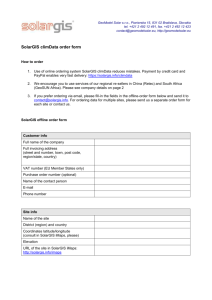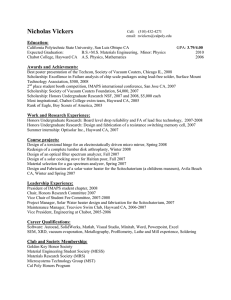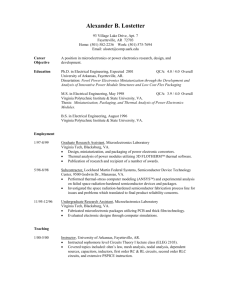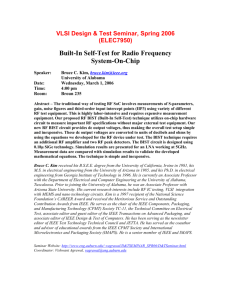Interactive Mobile Aquatic Probing System (IMAPS) William Weisnet William Collani
advertisement
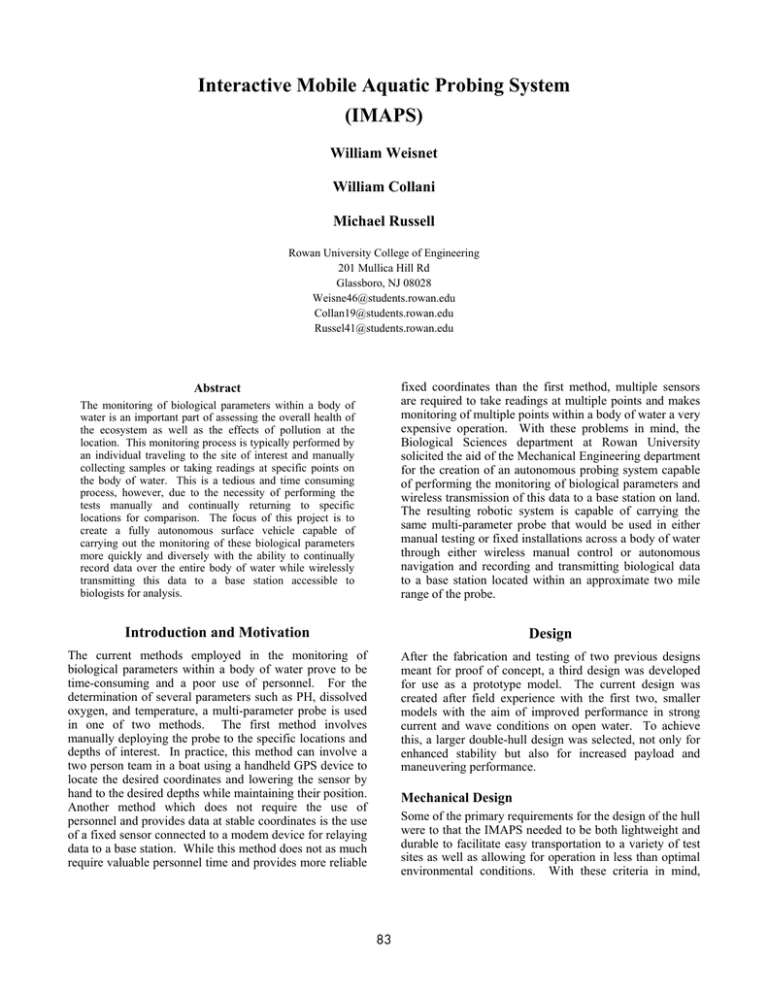
Interactive Mobile Aquatic Probing System (IMAPS) William Weisnet William Collani Michael Russell Rowan University College of Engineering 201 Mullica Hill Rd Glassboro, NJ 08028 Weisne46@students.rowan.edu Collan19@students.rowan.edu Russel41@students.rowan.edu The monitoring of biological parameters within a body of water is an important part of assessing the overall health of the ecosystem as well as the effects of pollution at the location. This monitoring process is typically performed by an individual traveling to the site of interest and manually collecting samples or taking readings at specific points on the body of water. This is a tedious and time consuming process, however, due to the necessity of performing the tests manually and continually returning to specific locations for comparison. The focus of this project is to create a fully autonomous surface vehicle capable of carrying out the monitoring of these biological parameters more quickly and diversely with the ability to continually record data over the entire body of water while wirelessly transmitting this data to a base station accessible to biologists for analysis. fixed coordinates than the first method, multiple sensors are required to take readings at multiple points and makes monitoring of multiple points within a body of water a very expensive operation. With these problems in mind, the Biological Sciences department at Rowan University solicited the aid of the Mechanical Engineering department for the creation of an autonomous probing system capable of performing the monitoring of biological parameters and wireless transmission of this data to a base station on land. The resulting robotic system is capable of carrying the same multi-parameter probe that would be used in either manual testing or fixed installations across a body of water through either wireless manual control or autonomous navigation and recording and transmitting biological data to a base station located within an approximate two mile range of the probe. Introduction and Motivation Design The current methods employed in the monitoring of biological parameters within a body of water prove to be time-consuming and a poor use of personnel. For the determination of several parameters such as PH, dissolved oxygen, and temperature, a multi-parameter probe is used in one of two methods. The first method involves manually deploying the probe to the specific locations and depths of interest. In practice, this method can involve a two person team in a boat using a handheld GPS device to locate the desired coordinates and lowering the sensor by hand to the desired depths while maintaining their position. Another method which does not require the use of personnel and provides data at stable coordinates is the use of a fixed sensor connected to a modem device for relaying data to a base station. While this method does not as much require valuable personnel time and provides more reliable After the fabrication and testing of two previous designs meant for proof of concept, a third design was developed for use as a prototype model. The current design was created after field experience with the first two, smaller models with the aim of improved performance in strong current and wave conditions on open water. To achieve this, a larger double-hull design was selected, not only for enhanced stability but also for increased payload and maneuvering performance. Abstract Mechanical Design Some of the primary requirements for the design of the hull were to that the IMAPS needed to be both lightweight and durable to facilitate easy transportation to a variety of test sites as well as allowing for operation in less than optimal environmental conditions. With these criteria in mind, 83 several materials were researched as possibilities for use in the fabrication of the hull with Luann plywood eventually being chosen for its relatively inexpensive cost and ease of obtaining the material. Buoyancy and stability calculations were carried out on multiple designs to find a solution that would be both stable in strong current or wave conditions and capable of carrying an increased payload to include the biological probe, an accompanying winch, and all the internal electrical components and sensors. The final hull is fabricated from Luann plywood coated in fiberglass and then painted. The final shape and size selected and fabricated can be seen in Figure 1 in the cart designed and built to transport the IMAPS on shore. Solutions-cubed electronic speed controllers, a MaxStream RF modem, a Garmin GPS receiver, a Raymarine sonar depth finder, and the multi-parameter probe from YSI Environmental. The electronic speed controllers are connected to the two forward motors used for propulsion as well as the motor used to operate the winch that raises and lowers the environmental sensor to different depths. The MaxStream RF modem is of the XStream model with a serial interface and operates at 900 MHz and 9.6 Kbps. The GPS receiver utilized for positioning information is a Garmin model GPS 16 which is waterproof and also capable of providing accuracy within less than three meters. The Raymarine depth finder allows the IMAPS to not only avoid lowering the biological sensor too deep into the water but also to create a depth profile of the body of water in which it is operating. The multi-parameter biological probe from YSI Environmental is the same type of sensory equipment a biologist may use if they were to perform the monitoring operations manually. The probe is capable of taking several simultaneous readings on multiple parameters including dissolved oxygen, turbidity, PH, depth, and temperature among others depending on the sensors the probe is equipped with. Software Design One of the end goals of the IMAPS project is for a biologist to be able to operate the system remotely without having to leave their lab or office over the internet. This was one reason it was decided to use Java to write the software needed to operate the system. Both the onboard software and the graphical user interface were created in Java. The IMAPS software was written to be modular so that addition or updating of future components would be relatively simple. The onboard software for the IMAPS is a Java application and currently runs in Windows XP. It runs on the onboard computer as long as the system is turned on. The GUI, a Java applet can either be used from the base station laptop or can be reached online from any computer and run in an internet browser. Currently the use of the GUI on the internet is limited to being able to access the GUI and being able to control the IMAPS only if the computer being used is connected to the base station RF modem. The IMAPS GUI currently allows for the system to be operable in two basic modes, manual operation and autonomous navigation. When configured for manual operation, the user is given control of the speed of the port and starboard motors based on percentages of full power in order to navigate as well as up and down buttons to control the level of the biological sensor. During manual operation, the onboard software receives the user commands from the GUI and relays them to the appropriate device as well as the opposite function of reading the data from the onboard sensors and relaying them to the base station to be displayed in the GUI. While running in autonomous navigation, the onboard software performs all the calculations and outputs the necessary Figure 1. Current IMAPS model Electrical Design The original IMAPS models utilized a network of PIC microcontrollers for managing the onboard sensors and actuators. To allow for greater functionality and easier future upgrades to the operating software, the current IMAPS model incorporates an onboard computer rather than the network of microcontrollers from earlier models. The use of the onboard computer allows for the system software to be written in any number commonly used and well known programming languages as well as communicating with all of the on board systems serially through the use of an USB hub. The onboard computer incorporates a motherboard based on the mini-ITX form factor measuring 170mm x 170mm. This motherboard was chosen for the low power consumption and fan less operation with suitable processing power for the application. Rather than implementing a standard parallel ATA hard drive, the onboard computer runs off of a compact flash card to conserve power and also eliminate moving parts in order to make the system more stable and reliable in potential rough travel and environmental conditions. The IMAPS onboard computer has six components connected to it serially through the use of its one serial port and two, four port USB hubs connected to the USB ports of the motherboard. The six components include three 84 commands to guide the IMAPS to its destination. The function of the GUI for autonomous operation is to accept user entry for GPS coordinates of waypoints to be relayed to the onboard software and also to start the autonomous function in the onboard software or to exit autonomous mode in the event of a problem. During both modes of operation, the GUI currently displays information in reference to the IMAPS current position and status. At all times, the current GPS coordinates of the IMAPS are displayed as well as the depth of the water that the IMAPS is measuring and its heading. Figure 2 shows a screen shot of the IMAPS GUI while in manual operation mode. actual use rather than just the ratings provided by the manufacturers. Many of the electrical components provide estimated current draws from the manufacturer but it was desirable to get actual data on the current draws when different components are in use and an average current draw for normal system operation to estimate current battery life and obtain data useful for future improvements to the electrical system. To make this testing easier to perform, it was carried out in the lab rather than in the water with an ammeter connected in series with the system while running different systems to determine current draw for different operations. In order to simulate field performance, the forward motor propellers were submerged in water to simulate the load they would be under in normal operation. Similarly, during winch operation a small load was manually put on the cable to simulate the effects of drag acting on the biological probe as it would be pulled through the water. The results of these tests yielded a nominal current draw of approximately 2.5 Amps with a maximum draw of approximately 8 Amps. This maximum draw situation, however, would mostly likely never occur in practice as it would result in the biological probe cable being dragged relatively far behind the IMAPS and in danger of coming into contact with the propellers. Based on these measurements and the current battery capacity of 20 Ah the IMAPS operation time can be estimated to be between three to six hours. Besides testing for determining the battery life of the IMAPS other useful parameters have been tested such as the range of the RF modem communication between the base station and the IMAPS. Unfortunately, a large enough open area providing line of site to a body of water was not available for the testing of the modem range so the only data able to be collected would be just a rough approximation. In order to test this range, the IMAPS was placed in the water and manually set to rotate with both motors set on equal speeds in opposite directions so that the linear motion of the IMAPS would be kept to a minimum. A team of students then took the base station and walked away from the body of water with it stopping intermittently to contact students by the body of water and change the direction of the IMAPS rotation to confirm that it was, in fact, still in range. This test resulted in confirmed ability to control the IMAPS from approximately 1.5 miles away through buildings and other obstructions. The most recent testing has been almost entirely involving the development of the autonomous navigation control. Currently, the IMAPS is capable of being given the GPS coordinates of destination waypoints obtained from readily available GPS mapping software. Once the coordinates are entered the user must simply hit the start button in the GUI and wait for the IMAPS to reach the destination. The one current condition that makes this navigation process more difficult is that the IMAPS does not currently include a digital compass and therefore has no sensor capable of providing the current heading of the system as it travels Figure 2. IMAPS GUI in manual operation mode Performance The current IMAPS has been tested several times, especially in the development of its current autonomous software. The dual forward motors have proven to provide the IMAPS with very tight maneuvering abilities from individual operation of varying levels of power or in opposite directions if the situation warrants this operation. When both motors are operated at equal power levels in opposite directions, the IMAPS is capable of rotating while remaining very nearly stationary. If both motors are to be operated simultaneously at full power in the forward direction, the IMAPS is capable of reaching speeds estimated at approximately two meters per second. The IMAPS has also been tested in a variety of environmental conditions ranging from a calm pond to a lake on a windy day to a bay inlet with significant larger waves than seen at any other test location. In all situations, the IMAPS was still capable of maneuvering effectively, although somewhat slower with the large waves. While its motion was slowed in the rougher water, there was never a danger of the IMAPS being capsized and it maintained relative stability in each of the environments. In addition to maneuvering and environmental performance testing, the IMAPS had to go through several system tests to determine certain system parameters in 85 between waypoints. This lacking of instrumentation is overcome using simple geometric principles to calculate its heading relative to the direction to the destination waypoint if the system were to travel to the point in a straight line from its current location. One assumption made in the autonomous navigation of the system is that the earth’s radius is sufficiently large enough relative to the distance it will be traveling to assume that lines of latitude are parallel to each other and perpendicular to lines of longitude which are also parallel to each other. When the IMAPS receives the signal to begin autonomous navigation, its first action is to save its current GPS coordinates to a variable and then to activate both forward motors at their minimum power level in order to move forward slowly. The system will continue to travel slowly forward until it determines that the current GPS coordinates read from the Garmin GPS 16 receiver have changed from the coordinates saved as its starting point. From these two sets of GPS coordinates the IMAPS can then use an arctangent function, specifically atan2, to determine its heading relative to lines of latitude and store this angle to a variable. Following this calculation, the autonomous function then uses the current GPS coordinates and the coordinates for the destination entered by the user to first determine the distance to the destination using the Pythagorean theorem and then applies the same arctangent function to these sets of points to find the heading from the current location to the destination relative to lines of latitude and saves these values to variables. This information is then used in a proportional control to determine the speed outputs for each motor in order to move toward the destination coordinates. Currently the autonomous function maneuvers toward the waypoint by activating one motor at a top speed proportional to the distance to the destination waypoint and the other motor at a speed proportional to the difference between the current heading and the heading to the destination waypoint. If the calculated difference to the destination waypoint is greater than an arbitrary value, in this case equivalent to approximately ten feet, then the top speed output by one of the motors is equivalent to 100% power. Once this distance barrier is broken and the IMAPS is determined to be within ten feet of the destination waypoint, the top speed output is proportional to the distance from the destination waypoint. The differential between the two motor speeds is determined by finding the difference between the current heading of the IMAPS and the calculated heading to the destination waypoint and multiplying the maximum speed differential, currently set to be 150% of full speed, by the proportion of this angle difference out of 180 degrees. In this way if the IMAPS has determined that it is facing directly away from destination waypoint, it would turn by activating one motor forward at the calculated top speed and the other at 50% of the calculated top speed in reverse. The control was set up in this way to give the IMAPS a small turning radius to allow it to maneuver in smaller areas yet still be moving in a net forward direction to ensure the GPS coordinates continue to change as is necessary for the correct calculation of the current heading of the IMAPS. The autonomous function will continue to run a loop performing these calculations and adjustments repeatedly until the waypoint is reached and continue to run this loop if the user instruction was for it to stay at that specified waypoint for a time period, for instance while it lowers the biological probe to take readings at multiple depths. This simple autonomous ability has been tested several times on an open body of water since it currently has no means of obstacle avoidance as part of the function. The results have been plotted on a coordinate plane representing the latitude and longitude coordinates and one trial is displayed in figure 3 with a satellite image of the test site aligned to the appropriate latitude and longitude boundaries. Figure 3. Autonomous trial plotted over satellite image Future Improvements As are many current robotics projects, the IMAPS is a work in progress and has several planned improvements to be made to the current model in the near future. Most of the planned improvements will, of course, increase its functionality and improve upon its current capabilities. One major improvement that continues to be worked on is the advancing of the IMAPS autonomous functionality. Currently the IMAPS is capable of navigating to GPS coordinates but has no way of avoiding potential obstacle it encounters along the way. One of the first improvements in the systems obstacle avoidance will be to prevent the IMAPS from running aground or entering water too shallow for its operation. This will most likely be one of the fist improvements undertaken in the near future as it requires no additional hardware, only additions to the current autonomous function. This will most likely be accomplished in a similar fashion to the GPS navigation but keeping track of both current and previous depth measurements for comparison to determine how the depth of the water is changing and the rate of change in the depth. When the IMAPS encounters a section of water where it determines it should no longer proceed, the onboard software would have to cause the motors to 86 actuate to cause a turn or rotation in search of deeper water. The next phase of the obstacle avoidance would have to take into account surface obstacles. This would be more complicated since the current IMAPS model has very limited sensory ability at water level. Currently the only forward looking sensor onboard the IMAPS is a single camera, while this could potentially be useful for obstacle avoidance, the process could prove to be too processor intensive for the onboard computer to handle while performing other system functions. The surface level obstacle avoidance will likely be implemented with the addition of a forward facing sonar array to provide distance measurements across the whole forward horizon. Making an obstacle avoidance decision based on distances and the would be far less processor intensive and could bear some similarities to the current autonomous function by making a decision on the direction to turn based on which direction offers the shortest route to a clear path similar to how the current function decides which way to turn based on which way will correct its course quicker. Another planned improvement for the IMAPS is actually already underway as a new team of students begins to fabricate the next model. This new model will no longer be only aquatic like the current IMAPS; it will have amphibious capability which will greatly increase the functionality of the system. The new IMAPS will be more functional, especially in areas such as marches and areas with submerged obstacles such as sandbars. The amphibious abilities will also increase the possible usage of the IMAPS by allowing it to work in partial frozen bodies of water during winter months by traveling across ice between openings of flowing water. The amphibious functionality will also make deployment easier in areas where the water isn’t easily accessible by people or vehicles. As mentioned earlier in the performance section, the operation time of the current IMAPS is between three and six hours meaning that making the system rechargeable in the field would greatly increase its functionality. Even before the addition of a system for recharging the system in the field, the battery capacity on board may be increased simply to increase the battery life enough to last a full night since most options for field recharging will involve solar power. One option is the addition of solar panels to the top surface of the IMAPS to provide a trickle charge during the day to at least extend the operation time of the system but not enough for a single charge to last overnight without increased battery capacity. Another option would be the creation of a base station anchored in the water, probably also relying on solar power, that the IMAPS would be able to navigate to when the battery charge drops to a certain level and drive into a fitted docking area where the IMAPS would be plugged in for recharging without having to leave the water. This option has certain problems as well since the solar panel surface area would still have to be relatively large and the IMAPS would need some kind of exposed electrical connection in order for it to plug itself in, a potential electrical hazard for operation on open water and in poor weather conditions. The autonomous navigation function also will be seeing improvements in the near future as components are added and the algorithms are improved. The addition of a digital compass to the system will enhance it navigation ability by eliminating the need to calculate the current heading of the IMAPS but rather simply collect the data from the compass. This will simply the entire process of navigating to specific GPS point and allow for operation in more closely confined atmospheres since forward motion would no long be required to determine the heading the IMAPS would be able to utilize its ability to rotate with very little linear motion to its advantage when operating near a shoreline or other obstacles. Also the control used in the autonomous function is a relatively simple proportional control and an observer can easily see the IMAPS traveling in path that would be expected from a proportional control, seeming to swing back and forth as it adjusts its course. Converting this control to utilize integral and differential control as well will make for a smoother path and shorter times traveling between waypoints. Another addition to the autonomous system will be a safety mechanism for an instance if the IMAPS travels outside of the range of the RF modems and looses contact with the base station. This added function would simply use the on board navigation function to travel to a previous set of GPS coordinates where the system was within range of the base station and wait for further instructions. Another future addition to the IMAPS will be the implementation of the second type of autonomous functionality desired in the IMAPS, the ability to navigate based on biological data. Currently this is not possible because of limitation of the biological probe not allowing for the capture of live data with which to base navigation decisions on. The idea behind this navigation is to be able track biological disturbances in a body of water. The IMAPS would travel a search pattern either with the biological probe lowered to a specified depth or stopping at multiple locations momentarily to lower the probe. The IMAPS onboard computer would then compare successive readings from the biological sensor looking for changes to determine a direction in which the reading level increases. Once finding this gradient, the IMAPS would then shift its search pattern in the direction toward higher or lower levels depending on what the user is looking for. By using the biological data to navigate, the IMAPS would be finding the location where the biological parameter being monitored would reach a minimum or maximum and then hold that position allowing for the biologist to record the location and to use the onboard cameras to investigate as to the cause of the minimum or maximum reading of that parameter. Applications The potential applications for the IMAPS are numerous in education and scientific study. The system could be 87 implemented by biological scientists in the field on a body of water permanently for regular monitoring of the biological parameters the system is configured to measure. The use of an autonomous system to perform the parameter monitoring will greatly increase the efficiency of the user, allowing them to spend more time analyzing data rather than collecting it. Also the IMAPS could perform many more tests not only because it is capable of taking measurements quicker than human technicians but it will eventually also be able to work 24 hours a day and the users would not need to pay a technician overtime, thus saving them time and money. The IMAPS also has potential educational applications to be used for biological experiments in a classroom environment. It would make the use of field measurements in a classroom environment easier by not requiring a field trip since it could be controlled over the internet. The IMAPS could provide an environmental experience that may not otherwise be possible to students especially in city environments where a site for study may not be easily accessible. The ability of the IMAPS to remain on a body of water over time without human interaction could also yield wildlife footage otherwise hard to obtain as the local wildlife grow accustomed to the presence of the IMAPS. Its potential uses are numerous as it would save time and money in almost any application whether it be for biological study, education purposes, or any other use that could be imagined for an autonomous surface vessel equipped with sensors and controllable from practically anyplace with an internet connection. 88
